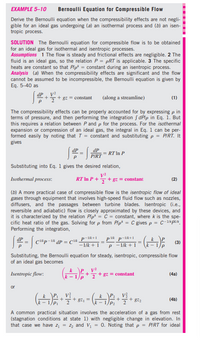
Elements Of Electromagnetics
7th Edition
ISBN: 9780190698614
Author: Sadiku, Matthew N. O.
Publisher: Oxford University Press
expand_more
expand_more
format_list_bulleted
Question
write what you understand in this example, simple answer

Transcribed Image Text:EXAMPLE 5–10
Bernoulli Equation for Compressible Flow
Derive the Bernoulli equation when the compressibility effects are not negli-
gible for an ideal gas undergoing (a) an isothermal process and (b) an isen-
tropic process.
SOLUTION The Bernoulli equation for compressible flow is to be obtained
for an ideal gas for isothermal and isentropic processes.
Assumptions 1 The flow is steady and frictional effects are negligible. 2 The
fluid is an ideal gas, so the relation P = pRT is applicable. 3 The specific
heats are constant so that Plp* = constant during an isentropic process.
Analysis (a) When the compressibility effects are significant and the flow
cannot be assumed to be incompressible, the Bernoulli equation is given by
Eq. 5-40 as
dP 4 V².
v?
+ gz = constant
(along a streamline)
(1)
The compressibility effects can be properly accounted for by expressing p in
terms of pressure, and then performing the integration S dPlp in Eq. 1. But
this requires a relation between P and p for the process. For the isothermal
expansion or compression of an ideal gas, the integral in Eq. 1 can be per-
formed easily by noting that T = constant and substituting p = PIRT. It
gives
dP
= RT In P
PIRT
Substituting into Eq. 1 gives the desired relation,
Isothermal process:
RT In P +
+ gz = constant
(2)
(b) A more practical case of compressible flow is the isentropic flow of ideal
gases through equipment that involves high-speed fluid flow such as nozzles,
diffusers, and the passages between turbine blades. Isentropic (i.e.,
reversible and adiabatic) flow is closely approximated by these devices, and
it is characterized by the relation Plp* = C = constant, where k is the spe-
cific heat ratio of the gas. Solving for p from Plp* = C gives p = C-/k pl./k.
Performing the integration,
P- +1
- 1/k + 1
dP = C
(3)
P - 1/k + 1
Substituting, the Bernoulli equation for steady, isentropic, compressible flow
of an ideal gas becomes
k P
Isentropic flow:
+ gz = constant
(4a)
- 1
+ gz, =
+ gz
(4b)
A common practical situation involves the acceleration of a gas from rest
(stagnation conditions at state 1) with negligible change in elevation. In
that case we have z
= z, and V, = 0. Noting that p = PIRT for ideal
.......
Expert Solution
This question has been solved!
Explore an expertly crafted, step-by-step solution for a thorough understanding of key concepts.
This is a popular solution
Trending nowThis is a popular solution!
Step by stepSolved in 2 steps with 2 images

Knowledge Booster
Learn more about
Need a deep-dive on the concept behind this application? Look no further. Learn more about this topic, mechanical-engineering and related others by exploring similar questions and additional content below.Similar questions
- Topic/s: Force System of a Force, Moment of a Force, Moment of a Force-Scalar Formulation,Moment of a Force-Vector Formulation, and Principle of Moment. Reminder: Kindly show the complete step-by-step solution. Please make sure that your handwriting is understandable and the picture of the solution is clear. I will rate you with “like/upvote” after. Thank you.arrow_forwardPlease show work for all these answers and a clear and short explantion of each onearrow_forward
Recommended textbooks for you
 Elements Of ElectromagneticsMechanical EngineeringISBN:9780190698614Author:Sadiku, Matthew N. O.Publisher:Oxford University Press
Elements Of ElectromagneticsMechanical EngineeringISBN:9780190698614Author:Sadiku, Matthew N. O.Publisher:Oxford University Press Mechanics of Materials (10th Edition)Mechanical EngineeringISBN:9780134319650Author:Russell C. HibbelerPublisher:PEARSON
Mechanics of Materials (10th Edition)Mechanical EngineeringISBN:9780134319650Author:Russell C. HibbelerPublisher:PEARSON Thermodynamics: An Engineering ApproachMechanical EngineeringISBN:9781259822674Author:Yunus A. Cengel Dr., Michael A. BolesPublisher:McGraw-Hill Education
Thermodynamics: An Engineering ApproachMechanical EngineeringISBN:9781259822674Author:Yunus A. Cengel Dr., Michael A. BolesPublisher:McGraw-Hill Education Control Systems EngineeringMechanical EngineeringISBN:9781118170519Author:Norman S. NisePublisher:WILEY
Control Systems EngineeringMechanical EngineeringISBN:9781118170519Author:Norman S. NisePublisher:WILEY Mechanics of Materials (MindTap Course List)Mechanical EngineeringISBN:9781337093347Author:Barry J. Goodno, James M. GerePublisher:Cengage Learning
Mechanics of Materials (MindTap Course List)Mechanical EngineeringISBN:9781337093347Author:Barry J. Goodno, James M. GerePublisher:Cengage Learning Engineering Mechanics: StaticsMechanical EngineeringISBN:9781118807330Author:James L. Meriam, L. G. Kraige, J. N. BoltonPublisher:WILEY
Engineering Mechanics: StaticsMechanical EngineeringISBN:9781118807330Author:James L. Meriam, L. G. Kraige, J. N. BoltonPublisher:WILEY

Elements Of Electromagnetics
Mechanical Engineering
ISBN:9780190698614
Author:Sadiku, Matthew N. O.
Publisher:Oxford University Press

Mechanics of Materials (10th Edition)
Mechanical Engineering
ISBN:9780134319650
Author:Russell C. Hibbeler
Publisher:PEARSON

Thermodynamics: An Engineering Approach
Mechanical Engineering
ISBN:9781259822674
Author:Yunus A. Cengel Dr., Michael A. Boles
Publisher:McGraw-Hill Education

Control Systems Engineering
Mechanical Engineering
ISBN:9781118170519
Author:Norman S. Nise
Publisher:WILEY

Mechanics of Materials (MindTap Course List)
Mechanical Engineering
ISBN:9781337093347
Author:Barry J. Goodno, James M. Gere
Publisher:Cengage Learning

Engineering Mechanics: Statics
Mechanical Engineering
ISBN:9781118807330
Author:James L. Meriam, L. G. Kraige, J. N. Bolton
Publisher:WILEY